|
|
 |
|
Cyclopoida ( Order ) |
|
|
|
Corycaeidae ( Family ) |
|
|
|
Farranula ( Genus ) |
|
|
| |
Farranula carinata (Giesbrecht, 1891) (F,M) | |
| | | | | | | Syn.: | Corycaeus pellucidus Brady, 1883 (part., p.112, Pl. 52, fig.19);
Corycäus carinatus Giesbrecht, 1891; 1892 (p.661, 675, 771, fig.F);
Corycaeus longicaudis : Cleve, 1900 (p.4, figs.M);
Corycaeus carinatus : F. Dahl, 1894 (p.69); Thompson, 1900 c (p.293); ? Wheeler, 1901 (p.192); A. Scott, 1902 (p.421); Thompson & Scott, 1903 (p.240, 285); Esterly, 1905 (p.226, figs.F); A. Scott, 1909 (p.246, Rem.); T. Scott, 1913 (p.578); Wilson, 1936 c (p.93); Park & Choi, 1997 (Appendix); Noda & al., 1998 (p.55, Table 3, occurrence);
Corycella carinata : Rose, 1929 (p.72); Wilson, 1932 (p.41); 1932 a (p.362); Rose, 1933 a (p.336, figs.F,M); Farran, 1936 a (p.139); Dakin & Colefax, 1940 (p.110, figs.M); Fish, 1962 (p.28); De Decker & Mombeck, 1964 (p.12); El-Maghraby, 1965 (p.58, Appendix); Mazza, 1966 (p.74); Gaudy, 1967 (p.88); Ehrhardt, 1967 (p.744, 887, figs.51-53, geographic distribution, Rem.); Séguin, 1968 (p.488); Delalo, 1968 (p.139); Dowidar & El-Maghraby, 1970 (p.268); Kovalev & Shmeleva, 1982 (p.86); Drira & al., 2010 (p.145, Tanl.2); El-Sherif & Aboul Ezz, 2000 (p.61, Table 3: occurrence); Zaafa & al., 2014 (p.67, Table I, occurrence);
Corycaeus (Corycella) carinatus : M. Dahl, 1912 (p.118, Taf XV, figs.7, 8, 11-14, 21, 31-34); Früchtl, 1923 (p.450); 1924 b (p.92); Wheeler, 1901 (p.192, figs.F); Dakin & Colefax, 1933 (p.209); Sewell, 1948 (p.393, 398); Tanaka, 1960 (p.87, figs.F, Rem.); Vilela, 1965 (p.16); Chen & al., 1974 (p.65, Pl.22, figs.13-15); Frontier, 1977 a (p.18); Zheng & al., 1982 (p.149, figs.F); Guangshan & Honglin, 1984 (p.118, tab.); Shih & Young, 1995 (p.76);
Corycaeus (Farranula) carinata : Böttger-Schnack, 1988 (p.313, 315); 1990 a (p.476 & suiv.); 1990 b (p.490 & suiv.); Böttger-Schnack & al., 1989 (p.1089);
Corycaeus carinata : Tremblay & Anderson, 1984 (p.7, Rem.)
Coricella carinatus : Cervigon, 1962 (p.181, tables: abundance distribution); | | | | Ref.: | | | Wilson, 1942 a (p.186); 1950 (p.227); Fagetti, 1962 (p.49); Motoda, 1963 (p.255, figs.F,M); Gonzalez & Bowman, 1965 (p.267, 268, Rem.); Owre & Foyo, 1967 (p.124, figs.F,M); Corral Estrada, 1970 (p.248, Rem.); Kos, 1972 (Vol.I, figs.F,M, Rem.); Vives, 1982 (p.296); Chihara & Murano, 1997 (p.967, Pl.219: F,M); Conway & al., 2003 (p.258, figs.F,M, Rem.); Boxshall & Halsey, 2004 (p.493, p.492: fig.F); Vives & Shmeleva, 2010 (p.224, figs.F,M, Rem.); Wi & Soh, 2013 (p.1, Rem.: 21, Table 1); 2013 a (p.1820, Redescr. F,M, figs.F,M, Rem.); Marquez-Rojas & al., 2014 (p.13, Descr. F,M, figs.F,M, Rem., %); |  issued from : Q.-c. Chen & S.-z. Zhang & C.-s. Zhu in Studia Marina Sinica, 1974, 9. [Pl.22, Figs.13-15]. As Corycaeus (Corycella) carinata. Female (from China Seas): 13, habitus (dorsal); 14, idem (lateral left side); 15, A2.
|
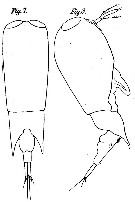 issued from : M. Dahl in Ergebnisse der Plankton-Expedition der Humboldt-Stiftung. Bd II, G. f1. I. Die Corycaeinen 1912. [Taf.XV, Figs.7, 8]. As Corycaeus (Corycella) carinatus. Female: 7, habitus (dorsal); 8, idem (lateral right side).
|
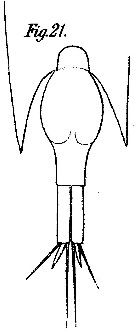 issued from : M. Dahl in Ergebnisse der Plankton-Expedition der Humboldt-Stiftung. Bd II, G. f1. I. Die Corycaeinen 1912. [Taf.XV, Fig.21]. As Corycaeus (Corycella) carinatus. Female: 21, urosome (dorsal).
|
 issued from : M. Dahl in Ergebnisse der Plankton-Expedition der Humboldt-Stiftung. Bd II, G. f1. I. Die Corycaeinen 1912. [Taf.XV, Figs.22]. As Corycaeus (Corycella) carinatus. Female: 22, lateral right side).
|
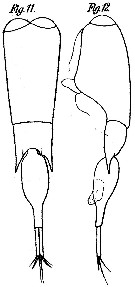 issued from : M. Dahl in Ergebnisse der Plankton-Expedition der Humboldt-Stiftung. Bd II, G. f1. I. Die Corycaeinen 1912. [Taf.XV, Figs.11, 12]. As Corycaeus (Corycella) carinatus. With doubt. Male, 11, habitus (dorsal); 12, idem (lateral left side)
|
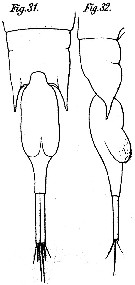 issued from : M. Dahl in Ergebnisse der Plankton-Expedition der Humboldt-Stiftung. Bd II, G. f1. I. Die Corycaeinen 1912. [Taf.XV, Figs.31, 32]. As Corycaeus (Corycella) carinatus. Male: 31, posterior portion of metasome and urosome (dorsal); 32, idem (lateral right side).
|
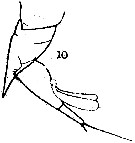 issued from : G.P. Farran in Proc. zool. Soc. Lond., 1911. [Plate XI, Fig.10]. As Corycella carinata. Female (from Christmas Island, Indien): 10, last thoracic segments and urosome (lateral).
|
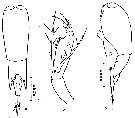 issued from : Z. Zheng, S. Li, S.J. Li & B. Chen inMarine planktonic copepods in Chinese waters. Shanghai Sc. Techn. Press, 1982 [p.150, Fig.95]. Female: a-b, habitus (dorsal and lateral, respectively); c, A2. Scale bars in mm.
|
 Female: Urosome about 2 times as long as the caudal rami and, in lateral view, appears more or less humpbacked. In lateral view of the urosome, the dorsal margin is irregularly humpbacked, and its greatest elevation is located anterior to the middle of the urosome. Male: Urosome less than 3 times as long as the caudal rami; rami much more than twice as long as broad. Posterior margin of the genital enlargements separated from the posterior end of the urosome by about 1/3 the length of the urosome.
|
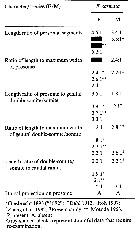 Issued from : J.H. Wi & H.Y. Soh in J. Nat. Hist., 2013. [p.3, Table I]. Length and width proportions of body segments of Farranula carinata. Nota: Compare with other species of Farranula (on line: http://dx.doi.org/10.1080/00222933.2012.708454).
|
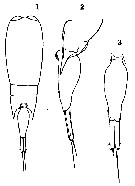 Issued from : O. Tanaka in Spec. Publs. Seto mar. biol. Lab., 10, 1960 [Pl. XXXVIII, 1-3]. As Corycaeus (Corycella) carinatus. Female (from 13°44'S, 68°22'E): 1, habitus (dorsal); 2, abdomen (lateral); 3, abdomen (dorsal). Nota: Cephalothorax and abdomen in the proportional lengths 68 to 32. 3rd dorsal thoracic segment without hump. posterior projection of the 4th thoracic segment does not reach the middle of the genital, segment. Abdominal segment and caudal rami in the proportional lengths 67 to 33 (viz 2.03) Genital segment 2.7 times as long as broad, and 2.7 times as long as broad, and 2.7 times as long as high.; the ventral pad markedly produced. Caudal rami 6.7 times as long as broad. Outer marin of the 2nd and 3rd exopodal segments of P1 to P3 finely serrated. Remarks: For Tanaka (1960, p.87) the specimen at the station 4 from the Indian Ocean is closely allied to F. concinna, but differs by several characters. The specimen comes near to F. carinata but shows some differences. It is also closely F. gracilis.
|
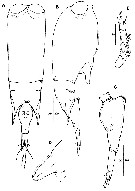 Issued from : J.H. Wi & H.Y. Soh in J. Mar. Biol. Ass. U.K., 2013, 93 (7). [p.1820, Fig.6]. Female (from 126°56.36'N, 33°16.40'E): A-B, habitus (dorsal and lateral, respectively); C, urosome (lateral); D, ventral cephalothorax process; E, A1. Nota : Prosome length about 2.2 times longer than urosome including caudal rami, 3.1 times longer than urosme excluding caudal rami. 1stprosomal somite with ventral process, about 1.4 times longer than width at base (fig.6D). 2nd prosomal somite without dorsoposterior projection on third pedigerous somite in lateral view, with extended and pointed posterilateral corners reaching to ¾ distance of 2nd urosomal somite and small protrusions on inner distal part in dorsal view. Proportional lengths (%) of urosomites and caudal rami 7.8 : 56.7 : 35.5. 2nd urosomal somite (fig.6A-C) rounded at 2/3 distance from anterior margin in dorsal view and forming irregular dorsal margin in lateral view, and the remainder slightly narrowing, 2.2 times longer than maximum width at anterior third, anteroventral margin protruded slightly upward, bearing patch of spinules, posteroventral and lateral margins fringed with minute spinules and denticles, posterior margin finely serrated ventrally (fig.6C). 2 secretory pores at just below genital apertures and 3 secretory pores at distal margin of 2nd urosomal somite in dorsal view. Caudal rami about 2.4 times shorter than 2nd urosomal somite, 4.7 times longer than wide at base. Outer seta III 3 times shorter than dorsal seta V and seta IV 1.9 times longer than seta V. A1 6-segmented, proportional lengths (%) of segments measured along posterior non-setiferous margin 24 : 9.3 : 14.7 : 26.7 : 12 : 13.3.
|
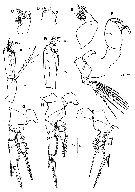 Issued from : J.H. Wi & H.Y. Soh in J. Mar. Biol. Ass. U.K., 2013, 93 (7). [p.1821, Fig.7]. Female: A, A2 (dorsal view); B, same (endopod, ventral view); C, Md (dorsal view); D, Mx1; E, Mx2 (dorsal view); F, Mxp; G, P1; H, P2; I, P4. Nota : A2 similar to that of F. orbisa except 1st endopodal segment about 2.8 times longer than wide at base, length ratio of outer distal spine to its branched spine on 2nd endopodal segment 3 : 1, and terminal spine and outer spine on third endopodal segment almost equal in length. Md, Mx1 and Mx2 similar to those of F. orbisa. Mxp similar to that of F. orbisa, but length of basis 1.6 times as long as wide at base and 3.3 times longer than distal seta, and distal seta with more spinules along inner margin (indicated by arrow in fig.7F), as compared to that of F. orbisa.
|
 Issued from : J.H. Wi & H.Y. Soh in J. Mar. Biol. Ass. U.K., 2013, 93 (7). [p.1819, Table 1]. Comparison of respective proportion for each segment and width among four species of Farranula.
|
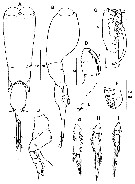 Issued from : J.H. Wi & H.Y. Soh in J. Mar. Biol. Ass. U.K., 2013, 93 (7). [p.1822, Fig.8]. Male: A-B, habitus (dorsal and lateral, respectively); C, A2 (ventral view); D, Mxp; E, P5; F, P6 (right side); G, exopod of P1; H, exopod of P2; I, exopod of P3; J, P4. Nota : Prosome 2-segmented, 1.3 times longer than urosome including caudal rami, 1.8 times longer than urosome excluding caudal rami. 2 large cuticular lenses located at very close to each other on frontal margin. 2nd urosomal somite about 2.5 times as long as maximum width at 1/3 distance from anterior margin, posterior part between sharply narrowing region (indicated by arrows in fig.8A) and rear margin 2.4 times shorter than rest of 2nd urosomal somite and 1.5 times shorter than caudal rami. A1 similar to that of F. orbisa. A1 similar to that of F. orbisa, but coxo-basis 2.2 times longer than wide and 1st endopodal segment about 3.5 times as long as width at base. Mxp similar to that of F. orbisa, except length of basis to basal seta much longer than basal seta (3.8 times), as compared to that of F. orbisa (2.3 times longer). P5 similar to that of female. P6 similar to that of F. orbisa. Surface ornamented with unique pattern of many denticles and 2 small secretory pores ; inner part of surface covered with large irregular sized denticles.
|
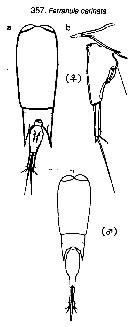 Issued from : M. Chihara & M. Murano (eds) in An illustrated Guide to the Marine Plankton in Japan, 1997. [p.977, Pl. 219, fig.357]. Female: a, habitus (dorsal, b, urosome (lateral). Male (after Motoda, 1963): habitus (dorsal).
|
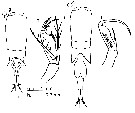 Issued from : B. Marquez-Rojas, O. Diaz-Diaz, L. Troccoli, J. Morales & L.M. Marcano in Métod. Ecol. Sistemat., 2014, 9 (3). [p.20, Fig.3, g-j]. Female (from Caraco Gulf, Venezuela): g, habitus (dorsal); h, A2. Male: i, habitus (dorsal); j, A2.
| | | | | Compl. Ref.: | | | Deevey, 1960 (p.5, Table II, annual abundance); Corral Estrada & Pereiro Muñoz, 1974 (tab.I); Zalkina, 1977 (p.339, tab.1); Deevey & Brooks, 1977 (p.156, tab.2, Station "S"); Lozano Soldevilla & al., 1988 (p.61); McKinnon, 1991 (p.471); Webber & Roff, 1995 (tab.1); Böttger-Schnack, 1995 (p.92); 1996 (p.1087); Suarez-Morales & Gasca, 1998 a (p.112); Lavaniegos & Gonzalez-Navarro, 1999 (p.239, Appx.1); Ueda & al., 2000 (tab.1); Seridji & Hafferssas, 2000 (tab.1); Lo & al., 2004 (p.468, tab.2); Lan & al., 2004 (p.332, tab.1); McKinnon & al., 2008 (p.843: Tab.I, p.848: Tab.IV); Morales-Ramirez & Suarez-Morales, 2008 (p.515, 524); Fernandes, 2008 (p.465, Tabl.2); Licandro & Icardi, 2009 (p.17, Table 4); Lan Y.-C. & al., 2009 (p.1, Table 2, % vs hydrogaphic conditions); Mazzocchi & Di Capua, 2010 (p.428); Medellin-Mora & Navas S., 2010 (p.265, Tab. 2); Hsiao S.H. & al., 2011 (p.475, Appendix I); Hsiao & al., 2011 (p.317, Table 2, indicator of seasonal change); Zizah & al., 2012 (p.79, Tableau I, Rem.: p.86); in CalCOFI regional list (MDO, Nov. 2013; M. Ohman, comm. pers.); Lidvanov & al., 2013 (p.290, Table 2, % composition); Zakaria & al., 2016 (p.1, Table 1); Benedetti & al., 2016 (p.159, Table I, fig.1, functional characters); Marques-Rojas & Zoppi de Roa, 2017 (p.495, Table 1); El Arraj & al., 2017 (p.272, table 2, spatial distribution); Palomares-Garcia & al., 2018 (p.178, Table 1: occurrence) | | | | NZ: | 17 | | |
|
Distribution map of Farranula carinata by geographical zones
|
| | | | | | | | | | | | | Loc: | | | South Africa (E), off S Cape Verde Is., Canary Is., off Morocco-Mauritania, Portugal, off Madeira, Patagonia, Barbada Is., Caribbean, Caribbean Colombia, Cariaco Basin, Bahia de Mochima & Cariaco Gulf (Venezuela), Caribbean Sea, Jamaica, E Costa Rica, G. of Mexico, Cuba, Florida, Sargasso Sea, off Bermuda (Station "S"), Delaware Bay (outside), Chesapeake Bay, off Woods Hole, off E Nova Scotia, off SW Ireland, off W Tangier, Medit. (Algerian Basin, G. of Lion, Marseille, Ligurian Sea, Tyrrhenian Sea, NW Tunisia, G. of Gabès, Egyptian coast, Alexandria), G. of Suez, Sharm El-Sheikh, Red Sea, Arabian Sea, off Minicoy Is., Sri Lanka, Madagascar (Nosy Bé), Seychelles, Indian, Bay of Bengal, Sulu Sea, Philippines, China Seas (East China Sea, South China Sea), Taiwan Strait, Taiwan (E, Tapong Bay, N), Jeju Is., Korea, S Japan Sea, Japan, Kuchinoerabu Is., Aleutian Is., Bering Sea, Pacif. (W equatorial), Australia (Great Barrier, New South Wales, Shark Bay, North West Cape), off Hawaii N, Pacif. (E equatorial), off W California, California, S. Baja California (La Paz), G. of California, W Costa Rica, off Galapagos, off S Easter Is., off Chile | | | | N: | 100 | | | | Lg.: | | | (34) F: 0,85-0,8; ? (45) F: 0,92-0,86; M: 0,8-0,75; (46) F: 0,9-0,85; (66) F: 0,91; (104) M: 0,86; (109) F: 0,92-0,77; (142) F: 0,92-0,86; (180) F: 0,98-0,9; M: 0,9-0,7; ? (188) F: 0,9-0,85; (373) F: 0,98; 0,89; M: 0,91; (666) F: 0,85; M: 0,78; (667) F: 0,79; M: 0,87; (785) F: 0,98; (788) F: 0,83-0,72; M: 0,78-0,7; (866) F: 0,83; M: 0,87; (991) F: 0,86-0,92; M: 0,75-0,85; (1023) F: 0,89; (1154)* F: 0,941-0,904; M: 0,894-0,866; {F: 0,72-0,98; M: 0,70-0,91}
*: Total body length in lateral view. | | | | Rem.: | epipelagic - ?. Overall Depth Range in Sargasso Sea: 0-500 m (Deevey & Brooks, 1977, Station "S");
For Gonzalez & Bowman (1965, p.268) confusions are possible between certain identifications of this species and Farranula gracilis.
After Ehrhardt (1967, p.888, 894) the species is found in the southwest Tyrrhenian Sea in water salinity between 37.08 - 38.16 p.1000 (mainly between 37.47 - 38.02).
See in DVP Conway & al., 2003 (version 1) | | | Last update : 28/10/2022 | |
|
|
 Any use of this site for a publication will be mentioned with the following reference : Any use of this site for a publication will be mentioned with the following reference :
Razouls C., Desreumaux N., Kouwenberg J. and de Bovée F., 2005-2025. - Biodiversity of Marine Planktonic Copepods (morphology, geographical distribution and biological data). Sorbonne University, CNRS. Available at http://copepodes.obs-banyuls.fr/en [Accessed January 01, 2026] © copyright 2005-2025 Sorbonne University, CNRS
|
|
 |
 |



















